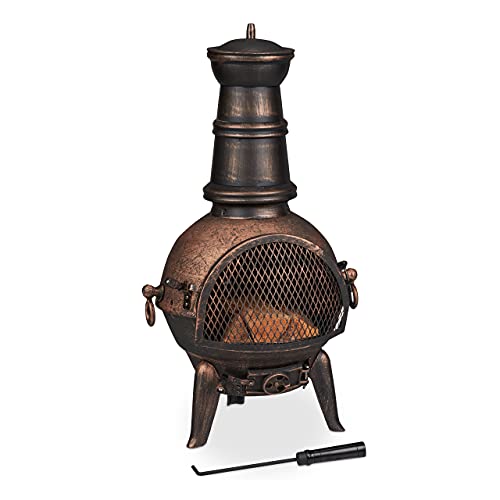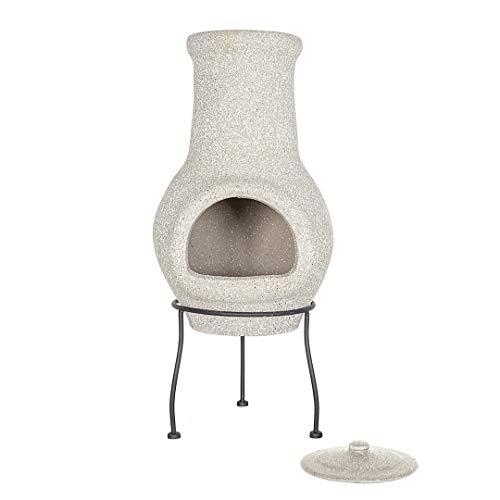
The Basics of a Ceramic
chiminea for sale
Clay is the most common material used to make chimineas. Think of terracotta pots, or red pottery. Clay is strong and hard but it can also crack when handled incorrectly.
The clay in a chiminea is very absorbent and has to be protected with gravel or sand at the bottom of the chiminea, along with logs and kindling. This stops the clay from getting too hot and prevents hairline cracks from forming.
Materials
Traditional clay chimineas, also called pot-bellied ovens, have chimneys that funnel smoke into the air. These types of chimineas are usually glazed to shield them from cracking and weathering because of sudden temperature changes. However, they remain vulnerable to rain and sun. This is why it is important to cover them when not in use, and to ensure that no water puddles develop within the clay.
The majority of chimineas are made from terracotta clay, although other materials such as cast iron and steel are available. Cast iron and aluminum are a long-lasting option that requires less maintenance. Terracotta has a classic Mexican appearance. Certain manufacturers offer modern designs which combine the beauty and durability of a chiminea that is made of clay.
Many people opt to pair their
chimineas with evergreens or flowering plants. This gives a natural appearance to add a natural feel to their backyard. It is important to choose plants that go together it is essential for a
best chiminea to be located in a place that is free of structures that can catch fire. It is important to ensure that the chiminea is placed in a safe area for fire, like concrete, brick, or stone patio.
Chiminesas are made by hand using high-fired, unglazed clay. The person who creates the clay is referred to as a potter. they can throw the piece on a potter's wheel or with a plaster mould. In either case, the clay is smoothed and kneaded before being dried. Some newer clay chimineas are pre-grogged, which is an additive that can help to withstand thermal stresses that are prone to cracking traditional earthenware.
Other chimineas are made in molds made of metal, which gives the chimineas a variety of design and shape that can be adapted to any backyard. Cast iron chimineas weigh a lot more than clay versions, but they stand up better to the elements and aren't as susceptible to cracking or breaking due to sudden temperature fluctuations as clay. They are more affordable than other types of chimineas as well, and they come with gas-burning models too to provide additional versatility.
Styles
Chimineas are fireplaces which can be decorated in a variety styles and materials. Terracotta chimineas provide the classic look that has been around for centuries, while metal options are more durable and be able to withstand high temperatures. Many chimineas have decorative patterns and designs that complement the surrounding patio furniture. A rusty patina finish, for example, can give a chiminea an old-fashioned look, particularly when it is it is paired with iron and wood patio furniture.
Chimineas are typically designed to be freestanding, but they may also be mounted on a stone, brick, or concrete patio. Whatever you decide to place your chiminea, ensure that it is sheltered from winds and positioned away from any explosive structures or plants. It is important to note that chimineas emit smoke as well as soot, which can affect the air quality of the area around it.
Some chimineas have a chimney that opens at the bottom of the structure, while others are pointed upwards and squat. Both styles are available with or without a wide opening for adding firewood. The chimneys of squat models may also be shaped to add visual appeal and create a more dramatic appearance.
You can also add decorative elements to the outside of your
chiminea large such as wrought iron, marble, or granite. For an added touch of flair, you might consider the option of a copper or ceramic top. These finishes reflect light and enhance the appearance of your chiminea.
A regular chiminea polish is a great option to protect your outdoor fire pit from harm and also beautify it. Make use of olive oil, beeswax or other natural products to polish the surface to give it a rich, glowing finish. Apply a thin coating and gently rub after which rinse and dry the chiminea for a radiant result.
Chimineas require a lot maintenance, but with the right care and attention, your unique
outdoor chiminea can look fashionable for a long time. With the help of practical decorating strategies and maintaining your chiminea's condition, you'll be able to enjoy it well into the cooler seasons.
Safety
Although chimineas are popular however they could pose a safety risk if not properly used. Clay chimineas, especially ones that aren't glazed, are prone to cracking and breaking. They can also be a fire risk when they are placed too close to flammable materials such as your home, furniture outdoors and in the garden. You should only use a chiminea outdoors and in an area that is enclosed or surrounded by fire-proof materials.
Keep a fire extinguisher close to you and use it to put out small flames, or hot coals, that might occur when you are tending to your flame. It is also a good idea to make use of a long lighter to light your fire and move coals around with tongs instead of using your hands. A bucket of water is also an excellent thing to keep close by in the event that the chiminea has to be extinguished. It is crucial to never use water to extinguish the chiminea that has been chilled down and to only add water after the fire has died naturally or if a huge fire is at risk of bursting into the chimney.
A simple spark stopper, made from chicken wire and positioned on top of the smokestack will protect your home and your neighbors from burns that could happen. Chimineas also produce a lot of heat and the area surrounding them can get extremely hot, which is why you should put up a low wall around the chiminea in order to warn people that getting close to it could result in painful burns.
It is not recommended to burn your chiminea in rainy or windy conditions, as sparks can set plants and possibly cause a chimney fire that could damage your home. Make sure to inquire with your local fire department if there burn bans in place before using the chiminea. Before adding firewood to your chiminea, make sure you clean the area around it. This will ensure that there aren't any flammable materials within the vicinity. It is also recommended to wash the inside of your chiminea following each use to avoid ash accumulation that could result in smoke inhalation as well as an ashy exterior.
Maintenance
Despite the fact that they can be used for outdoor fires, clay chimineas are not care-free devices. Like all things made of clay, they need to be handled with an amount of continuous care to ensure their longest life. It is important to not let them become too hot and to allow them to cool down between uses. Additionally they should be regularly cleaned and sealed to prevent the paint from being damaged by moisture.
The first step in keeping your chiminea in good condition is to remove the ashes that have accumulated after every use, but only after it has completely cooled down. It will still be warm, even if it appears to have cooled down, so make use of a small rake and a brush to clear away the ash. Once you have swept the ash out and disposed of it with care, the next step is to fill the bottom with either gravel or sand. If you don't do this the chiminea could crack. The clay absorbs moisture, and could crack if it is too dried.
Some sources suggest treating the exterior of a chiminea by using an acrylic waterproofing product similar to the ones used to seal tiles. This will prevent moisture from causing damage to the chiminea. It is recommended that the chiminea be cleaned and resealed every 6 to 8 weeks during times of heavy use.
Chimineas should only be burned on bare, fire-safe surfaces and they should never be placed on wood decking or on any other kind of overhead cover. Only using hardwood that is well-seasoned will lower the amount of sparks and prevent the clay from cracking.
A chiminea made of clay is not going to last for a long time. However, it is not a problem to break unless smash it with a heavy Hammer. However, cracks can develop for a variety of reasons, such as inadequate burning or a lack of maintenance. They are also susceptible to rust and need to be kept covered, at least when not in use. This will keep snow and rain from corroding the metal components.



